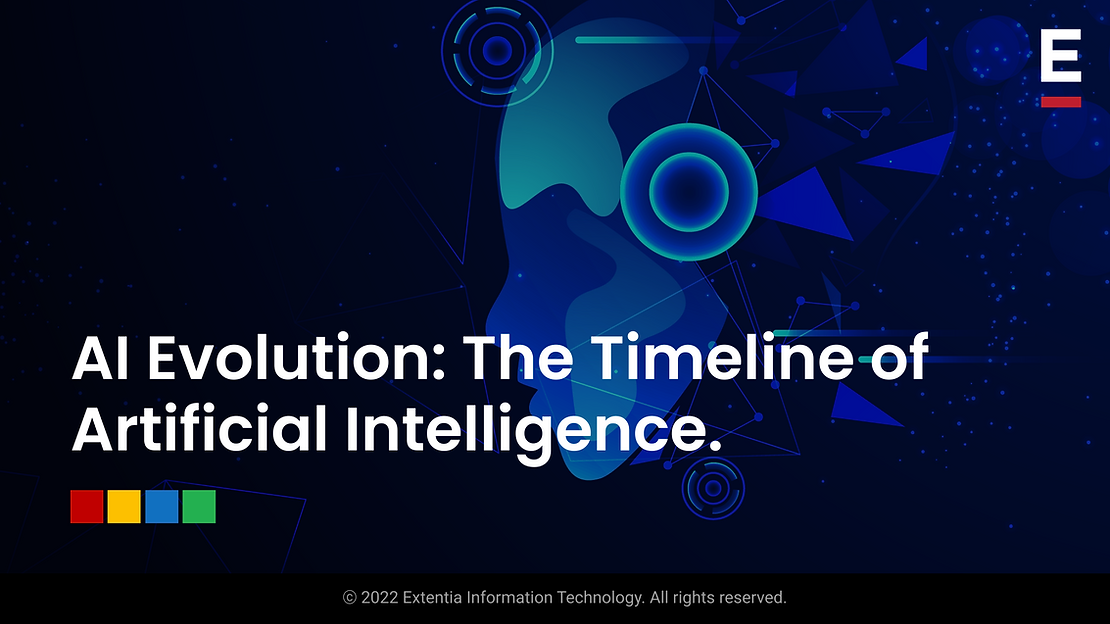Not so long ago, AI seemed a distant dream. Today it is everywhere and is gaining momentum in all industries. CIOs worldwide are planting AI firmly in their list of technologies to watch out for and invest in 2022 and ahead. It is said to drive most innovation across each industry sector in the next 1-5 years. Jerry Kurtz, Executive VP, Insights & Data, at Capgemini America, believes that – AI is an enabler and powerful capability, but the time for proofs of concept and science projects is quickly coming to an end. In 2022, expect AI engagements to become larger, more strategically significant, and more mission-critical – with a focus on long-term scalability. 2022 could be a year where AI will mature from experimental to essential.
But before we go ahead, let us try to trace the origins of Artificial Intelligence and understand how it all began? Which events shaped the development of AI since the time of its inception?
The History of Artificial Intelligence
In 1947, Alan Turing, the father of Computer Science, remarked, “I believe that at the end of the century, the use of words and general educated opinion will have altered so much that one will be able to speak of machines thinking without expecting to be contradicted.” And it would not be a stretch to say that he was right. Such is the nature of discovery, of the hitherto considered unknown becoming the norm, of the old making way for the new that it is almost unfathomable to begin with.
While the notion of thinking machines dates back to centuries, albeit in folklore and anecdotes, the coinage of the term AI can be traced back to the 1950s. In the almost seven decades since, Artificial Intelligence technology has developed and evolved in several ways, as have its applications.
The period between the 1950s and the 1970s in the history of AI revolved around the research on neural networks; the ensuing three decades (1980s to 2010s) were the dawn of the applications of Machine Learning. With consistent research, an ever-rising degree of intrigue, and widespread application, Machine Learning has made way for the subtler concept of Deep Learning. And the leap into the unknown that characterized the initial research in AI has become more of a leap of faith, with new chapters unfolding every year.
The Types of Artificial Intelligence – Narrow AI vs Strong AI
Artificial Intelligence has been broadly categorized into two branches: Narrow AI or Weak AI and Strong AI. Narrow AI is, as its name suggests, limited in its scope, and is essentially aimed at creating systems that can serve the same function as the human mind and enable automation. Some of the applications of Narrow AI are as follows:
Image and facial recognition software
Self-driving vehicles
Chatbots
Digital Assistants, for instance, Alexa and Siri
Recommendation Algorithms, for example, Netflix recommendations based on the watch history of a particular user
Another branch of AI, which is yet to be explored in its entirety, is Strong Artificial Intelligence. The notion of Strong AI is centered around the innovation of machines and systems that can completely replicate or exceed human intelligence and performance and imbibe the cognitive abilities and knowledge distinct to human beings. For such a system to become a reality, it would require not just human knowledge but other traits as well, such as human consciousness, critical thinking, behavioral patterns, to name a few.
How Does Artificial Intelligence Work?
At the core of AI technology are the three pillars of Machine Learning, Neural Networks, and Deep Learning, all of which revolve around processing complex data, establishing patterns, and applying algorithms and Natural Language Processing to generate the desired output. With Application Programming Interfaces (APIs), Artificial Intelligence technology can be used to existing software and hardware, such as home security systems, vehicles, etc. Although Artificial Intelligence has grown rapidly over the past few decades, there remains seemingly endless potential and applications yet to be explored.
AutoAI
AutoAI is a subset of AutoML, that is, Automated Machine Learning, which entails the automation of the end-to-end process of building and training the models of Machine Learning. Auto AI finds its application in the development of predictive Machine Learning models through the automation of the entire chain of tasks, ranging from preparing data sets to selecting the best models for further utilization.
AutoAI integrates several elements in the process mentioned above, such as:
Hyperparameter Optimization
Code Generation
Feature Engineering
Automated Model Deployment
Model Testing and Scoring
Explainable AI
To the naked eye, only the output of AI technology is visible, which, owing to its mystery, lends to a lack of trust amongst the users of said output. Explainable AI is an approach that makes Artificial Intelligence technology understandable and helps enhance its acceptance by humans. With the application of Explainable AI, it is easy to understand the structures and processes of a particular system using AI to establish transparency and adherence to regulatory requirements. The ability to comprehend how a specific output has been generated helps users trust and apply AI technology better. One can think of Explainable AI as similar to dining at a restaurant with an open kitchen; it unlocks the mystery behind the magic and makes it more understandable.
Well, we believe understanding AI will need more time and a few more blogs, and at Extentia, we plan to do just that – help you discover the facets of AI through a series of blogs. To give you a glimpse of why AI is so important to us – According to a few reports, AI will be better than human beings in translating languages by 2024, promoting items by 2031, and conducting surgical procedures by 2053. These statistics baffle us completely, and hence we bring our next AI blog that talks about various industry applications and innovations that are changing the world for the better.




